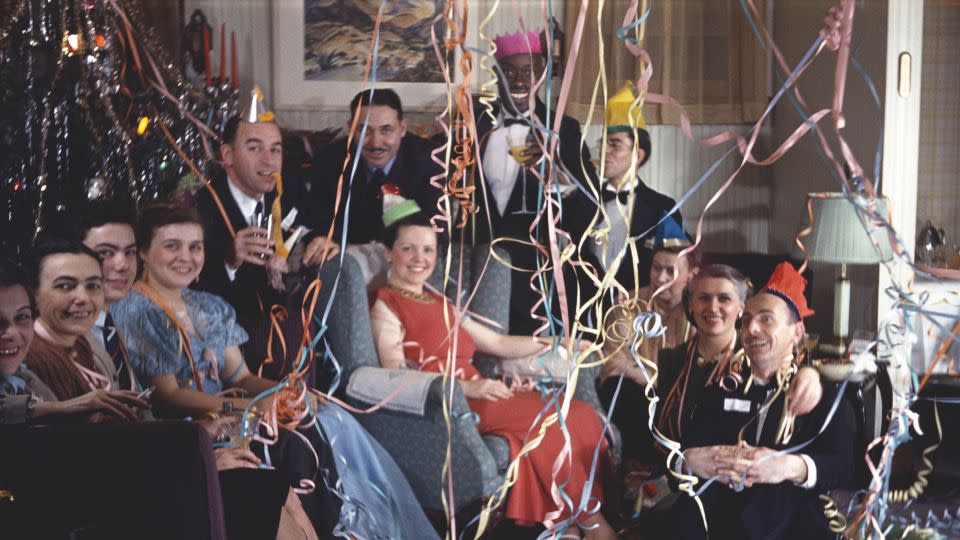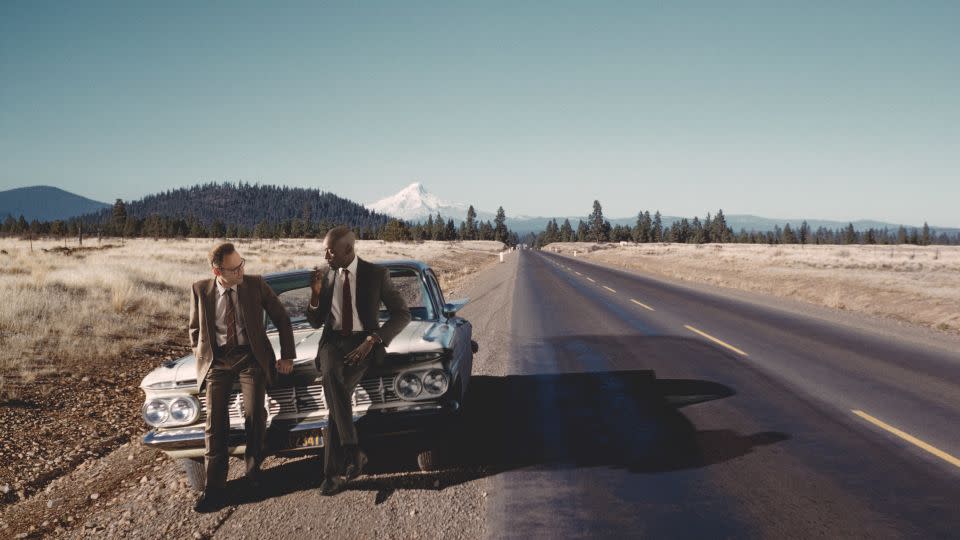A Black photographer added himself to places where history didn’t want him
In 1967 romcom “Guess Who’s Coming To Dinner,” Sidney Poitier’s dashing doctor is dropped into the lives of the Draytons, a White middle class family, when their daughter arrives home and announces she has a fiancé. The parents are liberals, but the news is shocking; they’re not sure if they approve of an interracial marriage. No matter that this man is handsome and of spotless character – he’s Sidney Poitier, for crying out loud – his presence, in all its Blackness, marks an intrusion, upending this hitherto White space.
Now imagine we know nothing about the Draytons. They could be civil rights campaigners or conservatives or card-carrying members of the KKK. And no Hollywood ending is guaranteed. That is the provocative space a puckish Omar Victor Diop finds himself in in “Being There.”
Conceived by British photographer Lee Shulman and Senegalese self-portraitist Diop, the series sees the duo utilize a collection of family photos from 1950s and 1960s America, editing Diop into a series of intimate scenes, both public and private, in spaces where Black people were often shut out.
The 60 or so photos, Kodachrome slides purchased on eBay by Shulman years ago, are drawn from his “Anonymous Project,” so named because Shulman has no idea of the identities of any of the people in them. The collection has spurred on multiple side projects, including a book with British photographer Martin Parr, and now “Being There,” which debuted at Paris Photo in November 2023 and was recently turned into a coffee table book.
“Being There” came to life when Shulman noticed many of the slides contained an empty seat – presumably that the photographer had vacated to take the photo. “There was an absence,” he told CNN in a joint video interview with Diop. That they were taken in America circa the civil rights movement, but also of a segregated South, “played on my mind a lot,” he explained. That absence became abstracted. The person missing from the seat evolved into a totem of worlds and peoples often excluded from the privileges of White America. “Every time I saw that chair, I saw Omar in (it),” Shulman added.

Though the two photographers had never met, it tracks. Shulman owned a few works from the acclaimed self-portraitist, who has prior experience in this area. Diop’s series “Diaspora” depicts Africans outside of Africa at different points in history (albeit with some contemporary – often soccer related – props). That sense of play and humor continues in “Being There,” in which an oft-grinning Diop offers a cheeky presence in each still.
Shulman and Diop curated the selection together. “We were looking for images that covered a broad spectrum of life, because it’s a family photo album,” said Shulman.
There are signs of wealth: a ski holiday, a Hawaiian jaunt, a trip to the Grand Canyon, alongside more modest adventures like a roadside picnic and a day at the zoo. The camera goes inside homes, capturing Diop in the back of birthday celebrations and lounging with families. However quotidian, that these moments were captured by cameras is a sign of race and class privilege, argued Shulman.
Other photographs, by nature of their location, are more charged. Diop splashes around in a public swimming pool; graduates from college; sits in a busy bar. He’s surrounded by White faces as he does so, occupying spaces which were historically segregated in some states. “The political potential of this series made it very easy for me to jump into this,” Diop said.
“We tend to have this glamorized gaze towards history. And in doing so, we forget how it’s easy not to make room for someone who’s different,” he added. “(The series) is an invitation to look at our lives nowadays and see how many people different from us that we allow into our intimate circles.”
Ironically, inserting Diop into these spontaneous shots involved a lot of planning. Period props and costumes were used by Diop in a greenscreen set, with rigs mimicking the lighting of each slide. Digital post-production slotted him into the photographs, approximating the grade and grain of Kodachrome film, along with any shadows, blur and movement in the shot.
Dressing up, Diop was struck by how much he looked like his father, who “laughed a lot going through the book,” the portraitist said.
“He’d been a student in Europe in the late ’50s, so he’d been sitting at these tables,” Diop added. “Of course, you can’t really compare (being an African in Europe) with what African Americans went through in the same era, but the idea of being different is something (they had in common).”

The collaborators never decided whether Diop is playing the same character in each photograph, or if it was a character at all, and not just Diop appearing as a time traveller. This ambiguity carries over into Diop’s relationship with the lens. “One of the reasons it works is that gaze he sometimes has towards the camera,” said Shulman, “you feel that he knows the photographer.” On the other hand, if it’s a case of Diop breaching the space-time continuum, photographs read as if he’s bringing the viewer in on the secret.
Likewise, neither resolved whether Diop was a welcome presence or gate-crasher in each scene.
Despite having the slides in his possession for years, Shulman still knows next to nothing about their subjects.
“As much as they’re anonymous, they tell us a lot,” he insisted. “Every time I look at these images, even without Omar in them, I feel these people are looking at us and telling us something about history.”
There is another, perhaps unintended, dimension to the photographs. The anonymity of the White people, and Shulman and Diop’s lack of desire to investigate them and their inner lives, forces the viewer to rely on sign and symbol to construct identity. We don’t know their politics, nor how they’d respond to Diop’s presence. Deprived of details, these lives become homogenized; bundled. In doing so, they’re treated like so many people of color were when portrayed by what was, for decades, a hegemonic Western – and almost exclusively White – lens, which had a knack for stripping away nuance. Diop’s winking presence, Black and African, seems to say, “Look where I am” but also, “See how you like it.”
Shulman insisted “there’s no pointing fingers in this book,” while later saying neither he nor Diop “feel like we own this project” now that’s out in the world and “lives its life.” All interpretations are valid, a fact they say excites them.
More than 60 years after the photos were taken, much of America appears different now. Gently probing, playfully satirical, Shulman and Diop remind us that much remains the same.
“It’s a very contemporary project,” Shulman said. “It has a lot of relevance to the world we live in today.”
“Being There” is published by Textuel and available now.
For more CNN news and newsletters create an account at CNN.com

 Yahoo News
Yahoo News 
